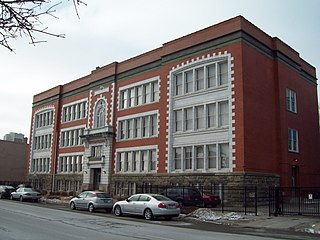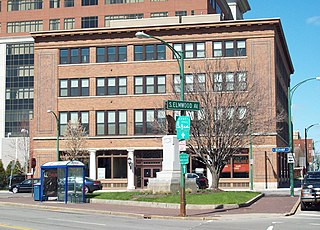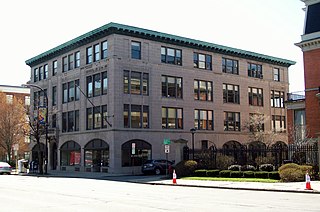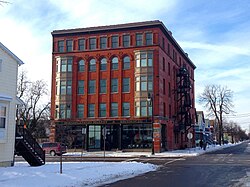
The Mentholatum Company, Inc. is a maker of non-prescription health care products founded in 1889 by Albert Alexander Hyde in the United States. It was bought out by Rohto Pharmaceutical Co., a Japanese health care company, in 1988. The Mentholatum Company is known for its top three products, Mentholatum Ointment, Mentholatum Deep Heating Rub, and Mentholatum Lip Care. The Mentholatum Building in Buffalo, New York was listed on the National Register of Historic Places in 2017.

Annunciation School is a historic parochial school building located at Buffalo in Erie County, New York. It was built in 1928 and is an "I" shaped brick structure representative of standardized, modestly sized school buildings of the period. It was operated by the Sisters of St. Mary of Namur. The school was closed as a parish school in 1988. It was home to the Catholic Academy of West Buffalo until 2005 and was converted to apartments in 2009–2010.

School 13, also known as Boys Vocational High School and Buffalo Alternative High School, is a historic school building located at Buffalo in Erie County, New York. It was built about 1915, and is a three-story, steel framed building sheathed in brick and terra cotta with Beaux-Arts style design elements. The "T"-shaped building housed administrative offices, classrooms, a gymnasium, swimming pool, and two-story auditorium. The building housed a school until 2003.

Buffalo Trunk Manufacturing Company Building is a historic factory and warehouse building located at Buffalo in Erie County, New York. It is a five-story, eight bay, red brick, "L" shaped, flat roofed industrial building constructed in two phases, 1901–1902 and 1906–1907. It is an example of "slow burn" masonry and wood factory construction.

Alling & Cory Buffalo Warehouse is a historic warehouse building located at Buffalo in Erie County, New York. It consists of a six-story, "L" shaped, 120,000-square-foot (11,000 m2) former paper warehouse building built in 1910-1911 for the Alling & Cory company of Rochester, with a one-story, brick loading dock addition built in 1926. It is built of reinforced concrete with classical detailing and considered to be of the "Daylight Factory" design. The building has been rehabilitated into an apartment complex.

St. Andrew's Episcopal Church is a historic Episcopal church complex located at Buffalo in Erie County, New York. The church was completed in 1928 and is a Neo-Gothic style edifice. It is built of cream and gray colored stone with a red ceramic tile roof. Also on the property is a Queen Anne style rectory (1910) and concrete block garage.

The Masonic Temple — Newport Lodge No. 445 F. & A.M. is a historic building located in Newport in Herkimer County, New York. Built in 1903 as a meeting hall for a local Masonic Lodge, the building is a 2 1⁄2-story, five-bay-wide by three-bay-deep wood frame building, with a rectangular main block and square shaped rear wing. It features a two tiered, semi-circular entry porch. The interior features Colonial Revival style detailing.

Morse Cobblestone Farmhouse is a historic home and farm complex located at Wilson in Niagara County, New York. It was constructed between about 1840 and 1845. It is an L-shaped cobblestone building with a 2-story, three-bay-wide main block and 1 1⁄2-story, four-bay side block and rear kitchen block in the Greek Revival style. It has a porch along the side wing added about 1910. It features irregularly shaped, variously colored cobbles in its construction. It is one of approximately 47 cobblestone structures in Niagara County. Also on the property are two fieldstone barns.

Kensington Gardens Apartment Complex is a historic apartment complex located at Buffalo in Erie County, New York. It was built in 1941–1942 and is a multi-unit apartment complex containing a total of 280, one-, two- and three-bedroom apartments in a variety of detached and semi-attached buildings in the Colonial Revival style. The 59 contributing buildings are grouped around grassed courts. There are 10 court areas created on the site and three building types within courts. It is an example of a World War II-era worker housing community built with financing by the Federal Housing Administration (FHA).

The Calumet is a historic commercial building located at Buffalo in Erie County, New York. It was designed in 1906, and is a three-story steel frame building covered in decorative architectural terra cotta. The distinctive glazed white and burnt sienna terra cotta is detailed with a centrally located reed or running stem and four leaves depicting the Calamus palm.

House at 218 Dearborn Street is a historic home located in the Black Rock neighborhood of Buffalo in Erie County, New York. It was built about 1880, and is a one-story, wood-frame shotgun-style workers cottage on a limestone foundation. It is three bays wide and has a low pitched gable roof. It features a hipped roof front porch with decorative spandrels, added about 1890. Also on the property is a shed dated to about 1890.

Robertson–Cataract Electric Building, also known as The Corn Exchange and 100 South, is a historic commercial building located in downtown Buffalo in Erie County, New York. It was built in 1915–1916, and is a four-story, five bay, reinforced concrete building faced in brick in the Renaissance Revival-style. The building was expanded in 1919. It features terra cotta and polychromatic brick details in hues of red, brown, and purple. It originally housed a retail showroom and warehouse space for the Robertson–Cataract Electric Co.

The Huyler Building is a historic commercial and office building located in downtown Buffalo in Erie County, New York. It was built in 1926, and is a four-story, four bay, reinforced concrete building faced in cast stone and brick in the Classical Revival-style. The front facade features three large segmental-arched display windows, balustraded balconet, and carved "Huyler's" logo with flanking griffons. Some of the interior commercial space at 376 Delaware was installed by Antonin Raymond (1888-1976) in 1939–1940. It was originally built for the Huyler's candy company and for over 80 years occupied by the locally prominent Pitt Petri store.
Esenwein & Johnnson was an architectural firm of Buffalo, New York.

Automobile Club of Buffalo is a historic clubhouse located at Clarence in Erie County, New York. It was designed by the architectural firm of Esenwein & Johnson and built in 1910–1911 in the Craftsman style. It is a two-story, "Y"-shaped, wood frame building with a low hipped roof and broad eaves. The building measures 184 feet long and 32 feet wide. It features a deep porte cochere, semicircular two-story tower, broad verandah, enclosed one-story porch, and two exposed chimneys. Also on the property is a contributing storage shed. The property was sold to the Town of Clarence in 1957, and is used as a town park. The Automobile Club of Buffalo joined the American Automobile Association in 1903, one of its earliest affiliates. The clubhouse was built to promote membership in the Automobile Club of Buffalo, and was one of only six country clubs built by similar organizations in the United States.

American Grain Complex, also known as "The American," Russell-Miller Milling Co. Elevator, and Peavey Co. Elevator, is a historic grain elevator and flour milling complex located in South Buffalo, Buffalo, Erie County, New York. The complex consists of three contributing buildings and two contributing structures. They are the Elevator Building, Flour Building (1906-1924), office building, Moveable Marine Tower, and railroad tracks. The Elevator Building consists of the mainhouse, workhouse, and fixed marine tower, all built in 1905–1906, and an annex constructed in 1931. The complex was last owned by ConAgra Foods, who closed the elevator and mill in June 2001.

Turner Brothers' Building–American Household Storage Company is a historic manufacturing and warehouse building located at Buffalo in Erie County, New York. The original section was built about 1848, and it is a four-story, wood frame, brick faced building in the Gothic Revival style. A six-story, two bay reinforced concrete addition was built in 1910. The building has three-story rear additions built in 1889 and 1940.

Dick Block is a historic commercial building located at North Tonawanda in Niagara County, New York. It was built in 1891 and is a three-story, three bay, red brick building in the Romanesque Revival style. It features rounded windows and arches, rusticated stone detailing, and ornamental brickwork. The first floor storefronts were modernized about 1946, when the building was occupied by the Witkop and Holmes Company furniture store.

Sibley and Holmwood Candy Factory and Witkop and Holmes Headquarters, also known as the Weed & Company Building, are two connected historic commercial buildings located in downtown Buffalo, Erie County, New York. The Sibley & Holmwood Candy Factory was built in 1896 and is a five-story, nine-bay-wide brick commercial block with late-Gothic detailing. It features Gothic window arches, decorative cast-iron columns on the storefront, and corbelled cornice. The Witkop & Holmes Headquarters was designed by the architectural firm Bethune, Bethune & Fuchs and built in 1901. It is a four-story, three-bay-wide brick commercial block. Both buildings have flat roofs. The building has been renovated to house loft apartments.

Buffalo Public School No. 24, also known as Public School 59, is a historic school building located in the Broadway-Fillmore neighborhood of Buffalo, Erie County, New York. The original section was built in 1901, and is a three-story, seven bay, "I"-shaped, red brick building over a raised basement with Renaissance Revival detailing. The building incorporates sandstone, terra cotta, and pressed metal details. It was the first school to offer special education within the City of Buffalo school system. The school has been redeveloped as an apartment building.
























